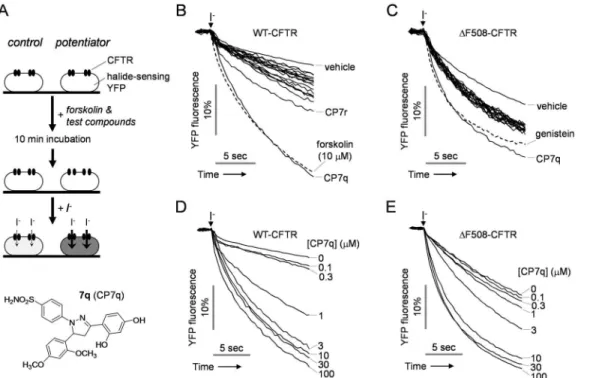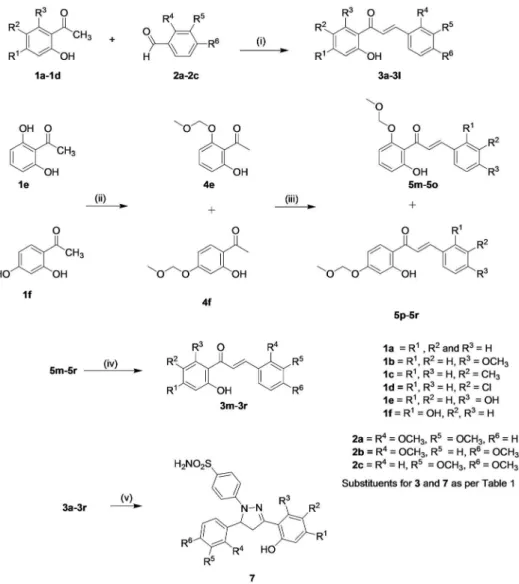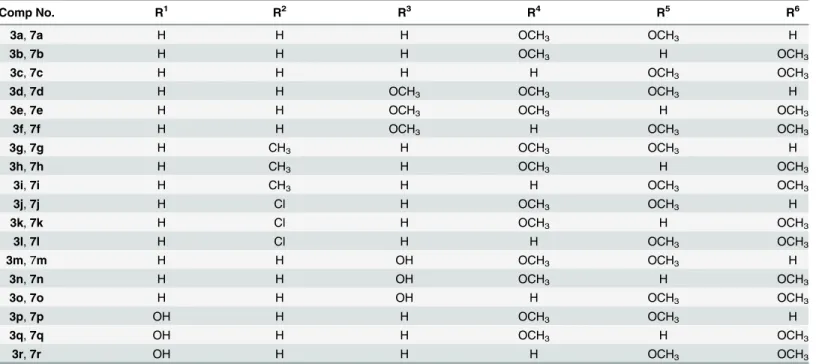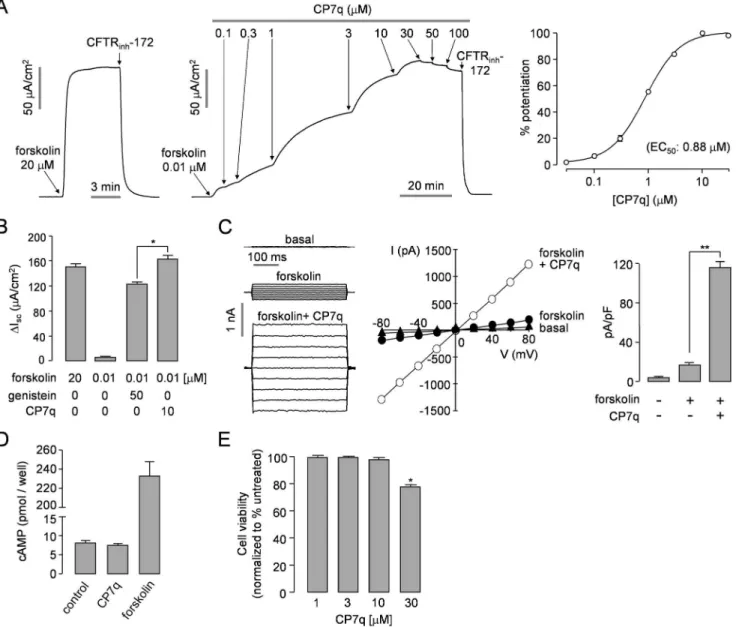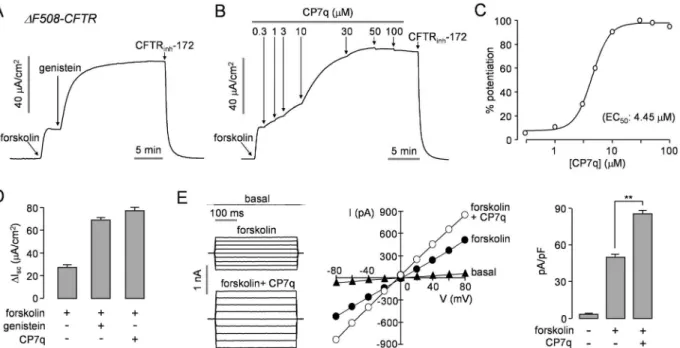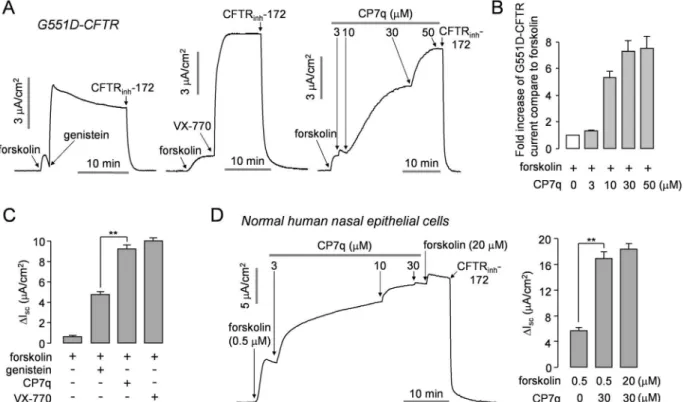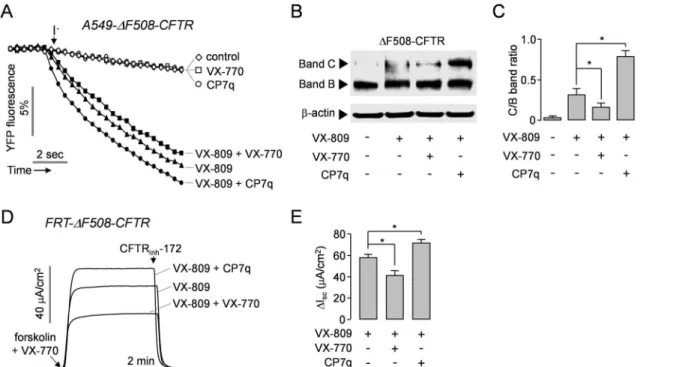Potentiation of
Δ
F508- and
G551D-CFTR-Mediated Cl
-
Current by Novel
Hydroxypyrazolines
Jinhong Park1,2☯, Poonam Khloya3☯, Yohan Seo1,2, Satish Kumar3, Ho K. Lee2, Dong-Kyu Jeon1, Sungwoo Jo1, Pawan K. Sharma3*, Wan Namkung1,2*
1College of Pharmacy, Yonsei Institute of Pharmaceutical Sciences, Yonsei University, Incheon 406–840, Korea,2Department of Integrated OMICS for Biomedical Science, WCU Program of Graduate School, Yonsei University, Seoul 120–749, Korea,3Department of Chemistry, Kurukshetra University, Kurukshetra, Haryana 136119, India
☯These authors contributed equally to this work.
*wnamkung@yonsei.ac.kr(WN);pksharma@kuk.ac.in(PKS)
Abstract
The most common mutation of CFTR, affecting approximately 90% of CF patients, is a dele-tion of phenylalanine at posidele-tion 508 (F508del,ΔF508). Misfolding ofΔF508-CFTR impairs both its trafficking to the plasma membrane and its chloride channel activity. To identify small molecules that can restore channel activity ofΔF508-CFTR, we synthesized and eval-uated eighteen novel hydroxypyrazoline analogues as CFTR potentiators. To elucidate potentiation activities of hydroxypyrazolines forΔF508-CFTR, CFTR activity was measured using a halide-sensitive YFP assay, Ussing chamber assay and patch-clamp technique. Compounds7p,7qand7rexhibited excellent potentiation with EC50value<10μM. Among
the compounds,7q(a novel CFTR potentiator, CP7q) showed the highest potentiation activity with EC50values of 0.88±0.11 and 4.45±0.31μM for wild-type andΔF508-CFTR,
respectively. In addition, CP7q significantly potentiated chloride conductance of G551D-CFTR, a CFTR gating mutant; its maximal potentiation activity was 1.9 fold higher than the well-known CFTR potentiator genistein. Combination treatment with CP7q and VX-809, a corrector ofΔF508-CFTR, significantly enhanced functional rescue ofΔF508-CFTR com-pared with VX-809 alone. CP7q did not alter the cytosolic cAMP level and showed no cyto-toxicity at the concentration showing maximum efficacy. The hydroxypyrazolines may be potential development candidates for drug therapy of cystic fibrosis.
Introduction
Cystic fibrosis (CF) is caused by loss of function mutations in the gene encoding CFTR, a cAMP-dependent chloride channel expressed primarily in the airways, pancreas, intestine and other organs [1–4]. The most common mutation responsible for CF is deletion of phenylala-nine at residue 508 (F508del,ΔF508) and this mutation causes protein misfolding that leads to a11111
OPEN ACCESS
Citation:Park J, Khloya P, Seo Y, Kumar S, Lee HK, Jeon D-K, et al. (2016) Potentiation ofΔF508- and G551D-CFTR-Mediated Cl-Current by Novel
Hydroxypyrazolines. PLoS ONE 11(2): e0149131. doi:10.1371/journal.pone.0149131
Editor:Jeffrey M. Beekman, University Medical Center Utrecht, NETHERLANDS
Received:June 9, 2015
Accepted:January 27, 2016
Published:February 10, 2016
Copyright:© 2016 Park et al. This is an open access article distributed under the terms of the
Creative Commons Attribution License, which permits unrestricted use, distribution, and reproduction in any medium, provided the original author and source are credited.
Data Availability Statement:All relevant data are within the paper and its Supporting Information files.
Funding:This work was supported by Basic Science Research Program through the National Research Foundation of Korea (NRF) funded by the Ministry of Education, Science and Technology (NRF-2012R1A1A1040142) and a grant of the Korea Healthcare technology R&D Project, Ministry for Health & Welfare Affairs, Republic of Korea (HI08C2149).
defects in trafficking to the plasma membrane. Even thoughΔF508-CFTR was properly local-ized to the plasma membrane by low temperature correction or small-molecule correctors, the
ΔF508-CFTR has defects in channel gating [5], plasma membrane stability [6] and thermal sta-bility [7,8]. G551D-CFTR mutation is found in about 4~5% of CF patients, and this mutation produces defects primarily in CFTR channel gating, but the expression, processing and locali-zation of this mutant protein remains normal [9].
To treat people with one or two copies of the F508del mutation, various F508del-CFTR cor-rectors have been identified including Corr-4a, VX-809, VX-325, KM11060, ibruprofen and trimethylangelicin [10–14]. VX-809 is a promising investigational corrector ofΔF508-CFTR that restores plasma membrane expression ofΔF508-CFTR and chloride channel function to approximately 14% of non-CF human bronchial epithelial cells [11]. In clinical trials, however, VX-809 treatment was able to improve functional expression ofΔF508-CFTR in the sweat gland but failed to show robust improvement in lung function of patients with CF who were homozygous for the F508del-CFTR mutation [15]. To overcome the limitations of first-genera-tion correctors such as VX-809, a recent study on identificafirst-genera-tion of small-molecule correctors showing synergy with VX-809 provided a different types of correctors that can increase efficacy when used in combination [16–18].
The gating defects of correctedΔF508-CFTR and other gating mutants, such as G551D, have led to the development of small-molecule potentiators that can enhance CFTR Cl- chan-nel activity. Several small-molecule compounds have been found to have potentiation activity forΔF508- and G551D-CFTR: VX-770, genistein, apigenin, phenylglycine-01 (PG-01) and VX-532 to name a few [19–23]. Kalydeco (ivacaftor, VX-770) is the first approved potentiator for the treatment of CF patients with the G551D-CFTR mutation [24] or some other rare gat-ing mutations includgat-ing G178R, S549N, S549R, G551S, G1244E, S1251N, S1255P and G1349D mutation [25]. VX-770 treatment of patients with G551D and other gating mutations demon-strated noticeable clinical improvements, including increase in the forced expiratory volume in 1 s (FEV1), decrease in pulmonary exacerbations, and weight gain compared to placebo group [26,27]. The studies on VX-770 clearly show that the corrector is a good therapeutic agent for people with CF who have gating mutations. Vertex Pharmaceuticals Inc. reported results of Phase 3 clinical trials of ivacaftor (VX-770) in combination with lumacaftor (VX-809) for CF patients who are homozygous for F508del-CFTR. The combination therapy revealed signifi-cant improvements in lung function and other key measures of the disease. In addition, U.S. Food and Drug Administration (FDA) approved the combination therapy, Orkambi (lumacaf-tor/ivacaftor), to treat the underlying cause of CF in people aged 12 or older who are homozy-gous for F508del-CFTR mutation on July 2, 2015 (www.vrtx.com). However, recent study showed that prolonged incubation with most of known potentiators including VX-770 and genistein reduced the correction efficacy of VX-809 and VX-661, an investigational corrector [28,29]. This result strongly suggests that the identification and optimization of potentiators are still needed to improve the clinical benefit of combination therapy of corrector and potenti-ator in CF.
To elucidate the effect of the hydroxypyrazolines on WT,ΔF508- and G551D-CFTR chloride channel activity and their potential usefulness for drug development, we carried out
electrophysiological studies in cell lines overexpressing CFTR and in primary airway epithelium. CP7q exhibited the highest activity and strongly potentiatedΔF508- and G551D-CFTR. The hydroxypyrazolines may provide new structural scaffolds for CF therapeutics development.
Methods
Materials and solutions
Forskolin, genistein and other chemicals, unless otherwise indicated, were purchased from Sigma. CFTRinh-172 was synthesized as described. The HCO3—buffered solution contained (in
mM): 120 NaCl, 5 KCl, 1 MgCl2, 1 CaCl2, 10 D-glucose, 5 HEPES, and 25 NaHCO3(pH 7.4).
In the half-Cl-solution, 65 mM NaCl in the HCO3—buffered solution was replaced by Na
gluconate.
Cell culture
Fisher rat thyroid (FRT) cells expressing human wild type-,ΔF508- and G551D-CFTR with a halide sensor YFP-H148Q/I152L were generously provided by Dr. Alan Verkman (University of California, San Francisco) and grown in F-12 Modified Coon´s medium supplemented with 10% FBS, 2 mM glutamine, 100 units/ml penicillin and 100μg/ml streptomycin [30]. A549 cells were obtained from Korean Cell Line Bank (Seoul, Korea) and the cells were stably trans-fected with humanΔF508-CFTR and the halide sensor YFP-H148Q/I152L/F46L, and main-tained in RPMI-1640 medium containing 10% fetal bovine serum (FBS), 100 units/ml penicillin and 100μg/ml streptomycin. HT-29 cells were maintained in DMEM medium con-taining 10% fetal bovine serum (FBS), 100 units/ml penicillin and 100μg/ml streptomycin. Pri-mary cultures of human nasal epithelial cells were generously provided by Dr. Jaeyoung Choi. Passage-2 human nasal epithelial cells were plated at a density of 1 x105per cm2onto 12-mm diameter, 0.4-μm pore polycarbonate cell culture inserts (Snapwell; Corning, Lowell, MA). The cells were maintained in 1:1 mixture of bronchial epithelial growth medium and Dulbecco’s modified Eagle’s medium containing 10% fetal bovine serum and all supplements [39]. The cells were grown at an air-liquid interface and medium was changed every 2–3 days. Cultures were used 21 days after plating at which time transepithelial resistance was 300–800 Ohm/cm2.
Microplate Reader Assay of CFTR potentiation
FRT cells expressing wild type- orΔF508-CFTR with the halide sensor YFP-H148Q/I152L were plated in 96-well black-walled microplates (Corning Inc., Corning, NY) at a density of 2 x104cells per well. WT-CFTR-YFP cells were incubated for 48 h at 37°C, and
FRT-ΔF508-CFTR-YFP cells were incubated for 24 h at 27°C after 24 h incubation at 37°C to rescue
ΔF508-CFTR localization. Assays were done using FLUO star Omega microplate reader (BMG Labtech, Ortenberg, Germany) and MARS Data Analysis Software (BMG Labtech). Each well of a 96-well plate was washed 3 times in PBS (200μL/wash). 100μL PBS was added to each well. Forskolin (0.1 and 10μM for WT- andΔF508-CFTR, respectively) and test compounds
(1μL) were added to each well. After 10 min, 96-well plates were transferred to the microplate
Short-circuit Current
Snapwell inserts containing CFTR-expressing FRT and primary culture of human nasal epithe-lial cells were mounted in Ussing chambers (Physiologic Instruments, San Diego, CA). Forsko-lin, genistein, CP7q and CFTRinh-172 were added to the apical and basolateral bath solution.
For FRT cells, the apical bath was filled with a half-Cl-solution and the basolateral bath was filled with HCO3—buffered solution, and the basolateral membrane was permeabilized with
250μg/mL amphotericin B. For primary cultures of human nasal epithelial cells, symmetrical
HCO3—buffered solutions were used and ENaC was inhibited by pre-treatment with amiloride
(100μM). All cells were bathed for a 20 min stabilization period and aerated with 95% O2/ 5%
CO2at 37°C. Apical membrane current and short-circuit current were measured with an
EVC4000 Multi-Channel V/I Clamp (World Precision Instruments, Sarasota, FL) and recorded using PowerLab 4/35 (AD Instruments, Castle Hill, Australia). Data were collected and analyzed with ADInstruments acquisition software Labchart Pro 7 software. The sampling rate was 4 Hz.
Patch-Clamp
Whole-cell patch-clamp recordings were performed on WT- orΔF508-CFTR-expressing FRT cells. The bath solution contained (in mM): 140 NMDG-Cl, 1 CaCl2, 1 MgCl2, 10 glucose and 10
HEPES (pH 7.4). The pipette solution contained (in mM): 130 CsCl, 0.5 EGTA, 1 MgCl2, 1
Tris-ATP, and 10 HEPES (pH 7.2). Pipettes were pulled from borosilicate glass and had resistances of 3–5 MOafter fire polishing. Seal resistances were between 3 and 10 GO. After establishing the whole-cell configuration, CFTR was activated by forskolin and/or CP7q. Whole-cell currents were elicited by applying hyperpolarizing and depolarizing voltage pulses from a holding potential of 0 mV to potentials between -80 mV and +80 mV in steps of 20 mV. Recordings were made at room temperature using an Axopatch-200B (Axon Instruments). Currents were digitized and analyzed using a Digidata 1440A converter (Axon Instruments), and pCLAMP 10.2 software (Molecular Devices, Sunnyvale, CA). Currents were low-pass filtered at 1 kHz and sampled at 5 kHz
Cyclic AMP Assay
FRT cells grown on 12 well culture plates were washed 3 times with PBS at 37°C and then incu-bated in PBS at 37°C containing 100μM IBMX for 5 min in the absence or presence of forsko-lin or CP7q. After 10 min incubation, the cells were washed with cold PBS and cytosolic cAMP was measured using a cAMP immunoassay kit (Parameter TM cAMP immunoassay kit, R&D Systems) according to the manufacturer's protocol.
Cell Proliferation Assays
HT-29 human colon adenocarcinoma cells were plated at a density of 1 x104per cm2on 96-well microplates. After 24 h incubation, cells were treated with hydroxypyrazolines and then incubated for 1 day. An equal amount of DMSO was added to the all control. The culture medium and the compounds were changed every 12 h. For MTS assay, the cells were reincu-bated with MTS for 1 hour. The soluble formazan produced by cellular reduction of MTS was quantified by measuring the absorbance at 490 nm with Infinite M200 (Tecan, Grödig, Austria) microplate reader. MTS assay was done using CellTiter 961
AQueous One Solution Cell Pro-liferation Assay kit (Promega, Madison, WI, USA).
Immunoblot
Na3VO4, and protease inhibitor mixture). Whole cell lysates were centrifuged at 15,000 g for
10 min at 4°C to remove the cell debris, and equal amounts (80μg protein/lane) of supernatant protein were separated by 4–12% Tris-glycine precast gel (KOMA BIOTECH, Seoul, Korea) and then transferred onto PVDF membrane (Millipore, Billerica, MA). Membrane was blocked with 5% non-fat skim milk in PBS including 0.05% Tween 20 for 1 hour at room temperature. This membrane was then incubated overnight with primary CFTR antibody (M3A7, Millipore, Billerica, MA). After washing with 0.05% Tween 20 in PBS (PBST), the blot was further incu-bated for 45 min at room temperature with an anti-mouse secondary antibody (Cell Signaling). The membrane was then washed three times with PBST for 5 minutes and then visualized using the ECL Plus western blotting detection system (GE Healthcare Amersham; Piscataway, NJ). The immunoblot results were analyzed quantitatively by ImageJ Software.
Statistical analysis
The results of multiple experiments are expressed as means ± SEM ofnobservations. Statistical analysis was performed with Student’s t-test or by analysis of variance as appropriate. Differ-ences were considered statistically significant whenP<0.05.
Results
Potentiation of CFTR by Novel Hydroxypyrazolines
To investigate whether novel hydroxypyrazolines potentiate CFTR Cl-channel activity, FRT cells were stably transfected with iodide-sensitive YFP and CFTR, and potentiation activity was tested using a cell-based fluorescence assay (Fig 1A). Iodide influx through CFTR was mea-sured by the addition of extracellular iodide after pre-incubation with the hydroxypyrazolines and forskolin, a cAMP agonist. Among the hydroxypyrazolines, 4-[3-(2,4-dihydroxyphenyl)-5-(2,4-dimethoxyphenyl)-4,5-dihydro-1H-pyrazol-1-yl] benzenesulfonamide (CP7q) most strongly potentiated WT- andΔF508-CFTR channel activity when CFTR was activated by 0.1 and 10μM forskolin in WT- andΔF508-CFTR expressing FRT cells, respectively (Fig 1B–1E). EC50values of the hydroxypyrazolines for WT- andΔF508-CFTR calculated from microplate
reader assay are given inTable 1.
Synthesis of Hydroxypyrazolines
The target hydroxypyrazolines (7a-7r) were synthesized by following synthetic route outlined inFig 2. The synthesis of hydroxypyrazolines rest on the intermediate hydroxychalcones 3a-3r which were synthesized by base catalyzed Claisen-Schmidt condensation reaction of the appro-priate acetophenones 1 with substituted benzaldehydes 2 [40]. The target hydroxypyrazolines 7a-7r were obtained by condensation of appropriate chalcones 3a-3r with 4-hydrazinobenzene-sulfonamide hydrochloride [36] in refluxing acidic ethanol. 4-Hydrazinobenzenesulfonamide hydrochloride in turn was preparedviadiazotization of sulfanilamide followed by reduction of the corresponding diazonium salt with stannous chloride [41].
The structures of all the synthesized chalcones 5m-5r, 3a-3r and hydroxypyrazolines 7a-7r was confirmed by their spectral (IR,1H NMR and13C NMR) data. In the1H NMR spectra of compounds 5m-5r, the presence of methylene protons flanked by two oxygen atoms corre-sponding to methoxymethoxy (MOM) group could be ascertained from a singlet resonating at ~δ5.30, which was further supported from13C NMR spectra exhibiting signal at ~δ95.3. The IR spectra of chalcones 3a-3r exhibited the characteristic absorption band for C = O stretching at ~1628 cm-1. All the synthesized chalcones in the present study were found to be geometri-cally pure withtrans-configuration as indicated by the coupling constant (JHα-Hβ= 15.6–15.3 Hz) in their1H NMR spectra. In general,1H NMR spectra of pyrazolines 7a-7r showed charac-teristic ABX pattern of three protons of pyrazoline including two at C4 and one at C5. C5-H of
pyrazoline resonated at ~δ5.70 as a doublet of doublet with coupling constants of 12.6 Hz and 5.6 Hz. The cis C4-H appeared as a doublet of doublet at ~δ4.11 with coupling constants 18.0
Hz and 12.6 Hz. The trans C4-H also appeared as a doublet of doublet at ~δ3.32 with coupling
constants 18.0 Hz and 5.6 Hz. The structure of 7a-7r was further supported by their13C NMR by the presence of signals ~δ60.7 and ~δ43.5 due to C5- and C4-pyrazoline carbon atoms
fur-ther confirmed the pyrazoline structure. A singlet exchangeable in D2O, present at ~δ7.04
could be assigned to the SO2NH2group present at 4-position of phenyl ring attached toN-1 of
pyrazoline ring. The experimental protocols of all synthesized compounds are presented inS1 file.
Fig 1. Identification of novel potentiators of human CFTR.(A) Assay protocol. FRT cells stably expressing the halide-sensitive cytoplasmic fluorescent sensor YFP-148Q/I152L and CFTR were incubated with forskolin and test compounds. The YFP fluorescence was measured in response to addition of iodide (top panel). Chemical structure of CP7q (bottom panel). (B) In WT-CFTR expressing FRT cells, the YFP fluorescence measured in single wells of 96-well plates, showing vehicle control, 10μM forskolin and 3μM hydroxypyrazolines in the presence of 0.1μM forskolin. (C) In FRT cells expressing
ΔF508-CFTR that has been rescued by low temperature, the YFP fluorescence measured in single wells of 96-well plates, showing vehicle control, 50μM genistein and 3μM hydroxypyrazolines in the presence of 10μM forskolin. (D) Representative traces showing iodide influx via WT-CFTR in the presence of the indicated concentrations of CP7q and 0.1μM forskolin. (E) Representative traces showing iodide influx via low temperature-rescuedΔF508-CFTR in the presence of the indicated concentrations of CP7q and 10μM forskolin.
Structure-Activity Relationship Analysis of Hydroxypyrazolines
In the present study a careful look at CFTR potentiation data and substitution pattern of newly synthesized hydroxypyrazolines 7 revealed that three compounds namely, 7p, 7q, 7r having 2,4-dihydroxyphenyl moiety attached at C3 of pyrazoline ring were found to be excellent
ΔF508-CFTR potentiators with EC50value in the range 4.8–8.9 M while compounds 7q and 7r
with EC50values 0.9 M and 2.4 M respectively were excellent WT-CFTR potentiators. Among
the eighteen compounds 7a-7r, compound 7q having hydroxy and methoxy substituents in the phenyl rings (Table 2) attached at C3 and C5 of pyrazoline ring exhibited best potentiation against bothΔF508-CFTR and WT-CFTR. Other fifteen compounds 7a-7o having hydroxy group at position-2 in the phenyl ring at C3 and other substituents at various positions exhibit varying degree of potentiation without following any definite trend. Presence of free hydroxy group at position-4 of phenyl ring at C3 and methoxy group at position-4 of phenyl ring at C5 of pyrazoline nucleus exhibited the best results. A more detailed and elaborate study is further required to establish a precise structure activity relationship.
CP7q Potentiates WT-CFTR Channel Activity
Apical membrane currents were measured to verify potentiation activity of CP7q, the most potent compound, in WT-CFTR expressing FRT cells (Fig 3A). Apical membrane Cl-current was measured in the FRT cells after basolateral membrane permeabilization with amphotericin B and in the presence of a transepithelial Cl-gradient (apical, 64mM; basolateral, 129mM). Apical membrane current measurements in FRT-WT-CFTR cells gave an EC50of ~ 0.88μM
for CP7q. The maximum efficacy of CP7q for CFTR potentiation was significantly higher than that of genistein when CFTR was stimulated by 0.1μM forskolin in WT-CFTR expressing cells (Fig 3B). Whole-cell patch-clamp showed that CP7q strongly potentiated CFTR Cl-current activated by 0.1μM forskolin without altering the linear I/V relationship of activated CFTR in Table 1. CFTR potentiation by hydroxy pyrazoline compounds.Structure-activity relationship of CFTR potentiator is shown. EC50values were
deter-mined by microplate reader assay.
Comp No. R1 R2 R3 R4 R5 R6 EC50(μM) WT- CFTR EC50(μM)ΔF508-CFTR
7a H H H OCH3 OCH3 H 18.5 45.6
7b H H H OCH3 H OCH3 32.4 68.8
7c H H H H OCH3 OCH3 10.3 30.1
7d H H OCH3 OCH3 OCH3 H 56.5 inactive
7e H H OCH3 OCH3 H OCH3 63.3 inactive
7f H H OCH3 H OCH3 OCH3 50.6 inactive
7g H CH3 H OCH3 OCH3 H inactive inactive
7h H CH3 H OCH3 H OCH3 10.9 inactive
7i H CH3 H H OCH3 OCH3 38.6 83
7j H Cl H OCH3 OCH3 H 92.5 inactive
7k H Cl H OCH3 H OCH3 13.1 inactive
7l H Cl H H OCH3 OCH3 41.2 inactive
7m H H OH OCH3 OCH3 H 8.7 42.2
7n H H OH OCH3 H OCH3 27 38.5
7o H H OH H OCH3 OCH3 24.3 inactive
7p OH H H OCH3 OCH3 H 12.7 8.6
7q OH H H OCH3 H OCH3 0.9 4.8
7r OH H H H OCH3 OCH3 2.4 8.9
FRT cells expressing WT-CFTR (Fig 3C). CP7q did not activate WT- andΔF508-CFTR with-out forskolin stimulation in whole cell patch-clamp recording, and CP7q-induced potentiation of CFTR Cl-current was almost completely blocked by 10μM CFTRinh-172 (S1 Fig). To test
whether CP7q increases CFTR Cl-channel activity via elevation of intracellular cAMP, we observed effect of CP7q in FRT cells and found out it did not affect the intracellular cAMP level (Fig 3D). CP7q thus potentiates CFTR without elevation of intracellular cAMP. To inves-tigate the cytotoxic effect of CP7q, HT-29 cells were incubated with different concentrations of CP7q for 24 h and then cell viability was assessed using MTS assay. Concentration of CP7q up to 10μM, where it showed maximum efficacy, showed no cytotoxicity (Fig 3E).
CP7q Potentiates
Δ
F508- and G551D-CFTR Channel Activity
Apical membrane current measurements were performed to characterize CP7q potentiation activity inΔF508-CFTR expressing FRT cells.ΔF508-CFTR was rescued by 24 h incubation at low temperature (27°C). CP7q significantly potentiated theΔF508-CFTR Cl-current activated Fig 2. Synthesis of the Hydroxy Pyrazolines as CFTR potentiators.(i) KOH, EtOH, stir; (ii) Chloro (methoxy)methane (MOMCl), K2CO3, Acetone, reflux; (iii) substituted benzaldehydes 2a-2c, KOH, EtOH, stir;
(iv) 3N HCl, reflux; (v) 4-hydrazinobenzenesulfonamide hydrochloride (seeMaterials and Methods).
by maximal cAMP stimulation in a dose-dependent manner with EC50value ofΔ4.45μM, and
the efficacy of CP7q was slightly higher than that of genistein (Fig 4A–4D). Whole-cell patch-clamp showed that CP7q significantly potentiated forskolin-induced Cl-current without alter-ing the linear I/V relationship of activated CFTR in FRT-ΔF508-CFTR cells (Fig 4E).
CP7q potentiation of the CF-causing gating mutant G551D-CFTR was further investigated. We measured apical membrane currents in FRT cells expressing G551D-CFTR to verify effect of CP7q on G551D-CFTR (Fig 5A–5C). Application of each of potentiators, genistein, VX-770, and CP7q significantly potentiated G551D-CFTR Cl-current stimulated with maximal cAMP stimulation. Interestingly, CP7q potentiation of the G551D-CFTR Cl-current activated by maximal forskolin was 1.9 times higher than that of genistein and comparable to VX-770.
CP7q Potentiates CFTR Channel Activity in Human Airway Epithelium
To investigate whether CP7q potentiates CFTR in human primary cells, we measured short-circuit current in primary cultures of normal human nasal epithelial cells. InFig 5D, CP7q remarkably potentiated CFTR Cl-current activated by 0.5μM forskolin in primary human air-way epithelial cells. The potentiated CFTR Cl-current was completely inhibited by 10μM CFTRinh-172, a specific inhibitor of CFTR. ENaC was inhibited by pretreatment of amiloride
to enhance the driving force for apical Cl-secretion.
CP7q Enhances Functional Rescue of
Δ
F508-CFTR by VX-809
To determine whether CP7q reduces the functional rescue ofΔF508-CFTR by VX-809 like VX-770 does, we observed the effect of CP7q on the VX-809-mediated rescue ofΔF508-CFTR. InFig 6A, YFP quenching assay showed that the combined treatment with CP7q and VX-809 for 48 hours significantly increased the functional rescue ofΔF508-CFTR compared to VX-809 treatment alone, but the combined treatment with 770 and 809 decreased VX-809-mediated rescue ofΔF508-CFTR in A549 cells expressingΔF508-CFTR. Immunoblot Table 2. Substitution pattern of hydroxypyrazolines (7a-7r) and intermediate hydroxychalcones (3a-3r).
Comp No. R1 R2 R3 R4 R5 R6
3a,7a H H H OCH3 OCH3 H
3b,7b H H H OCH3 H OCH3
3c,7c H H H H OCH3 OCH3
3d,7d H H OCH3 OCH3 OCH3 H
3e,7e H H OCH3 OCH3 H OCH3
3f,7f H H OCH3 H OCH3 OCH3
3g,7g H CH3 H OCH3 OCH3 H
3h,7h H CH3 H OCH3 H OCH3
3i,7i H CH3 H H OCH3 OCH3
3j,7j H Cl H OCH3 OCH3 H
3k,7k H Cl H OCH3 H OCH3
3l,7l H Cl H H OCH3 OCH3
3m, 7m H H OH OCH3 OCH3 H
3n,7n H H OH OCH3 H OCH3
3o,7o H H OH H OCH3 OCH3
3p,7p OH H H OCH3 OCH3 H
3q,7q OH H H OCH3 H OCH3
3r,7r OH H H H OCH3 OCH3
analysis revealed that the combined treatment with CP7q and VX-809 strongly increased the ratio of band C (mature glycosylated form) to band B (core-glycosylated, ER-retained protein) ofΔF508-CFTR compared to VX-809 treatment alone (Fig 6B and 6C). In addition, CP7q strongly increased apical membrane current ofΔF508-CFTR when combined with VX-809 while combined treatment with VX-809 and VX-770 decreased the apical membrane current in FRT cells expressingΔF508-CFTR (Fig 6D and 6E).
Fig 3. Characterization of CP7q, a small-molecule potentiator of CFTR.(A) Apical membrane currents measured in FRT cells expressing WT-CFTR. CFTR was potentiated by indicated concentrations of forskolin and CP7q (left and middle panel). CFTR current was inhibited by 10μM CFTRinh-172.
Summary of CP7q dose-response data (right panel) (mean±S.E., n = 3). (B) Summary of peak currents (mean±S.E., n = 3). (C) Whole-cell CFTR Cl
-currents were recorded at a holding potential at 0 mV, and pulsing to voltages between±80 mV (in steps of 20 mV) in FRT cells expressing WT-CFTR (left panel). CFTR was slightly activated by 0.1μM forskolin and potentiated by 10μM CP7q. Current/voltage (I/V) plot of mean currents at the middle of each voltage pulse (middle panel). Summary of current density data measured at + 80 mV (mean±S.E., n = 5, right panel). (D) Intracellular cAMP accumulation in FRT cells in response to addition of CP7q (10μM) and forskolin (10μM) (mean±S.E., n = 4). (E) Effect of CP7q on cell viability 24 h after treatment as evaluated by MTS assays in HT-29 cells (mean±S.E., n = 6).*P<0.05,**P<0.01.
Discussion
Efforts aimed at the discovery and development of small-molecule modulators of CFTR as therapeutic agents for CF have produced some promising results such as Kalydeco (ivacaftor, VX-770) and Orkambi (lumacaftor/ivacaftor). Kalydeco showed remarkable clinical improve-ments in CF patients who have the G551D gating mutations [26,27]. However, Orkambi tar-geting CF patients with the most common CF mutation, F508del, only offered a small improvement in lung function. Thus, there is a demand for development of novel correctors and potentiators, or more potent combinations of CFTR modulators for the clinical benefit of combination therapy in CF patients with F508del mutation.
Genistein enhances CFTR Cl-current in various cell type and tissues, and the other flavo-noids such as apigenin, kaempferol and quercetin also stimulate CFTR Cl-current [21]. These flavonoids have a central heterocyclic ring and an aromatic substituent with hydroxy groups. Thus, to develop a new CFTR potentiator, we synthesized the hydroxypyrazolines with hydroxy groups like flavonoids and also with a benzenesulfonamide group which can easily participate in hydrogen bonding. In the present study, we revealed that CP7q, a hydroxypyra-zoline, is a novel potentiator of CFTR which strongly potentiates WT-,ΔF508- and
G551D-CFTR channel activity. Notably, we showed that CP7q potentiated 1.9 times more G551D-CFTR Cl-current than genistein (Fig 5C). In this study, we could not evaluate the effect of CP7q onΔF508- and G551D-CFTR channel activities in primary airway epithelial cells because of the limited access to primary cells derived from the CF patients. However, to investi-gate the effect of CP7q on CFTR in primary airway epithelial cells, we measured short-circuit current in primary cultures of normal human nasal epithelial cells and showed CP7q potently Fig 4. CP7q potentiatesΔF508-CFTR.Apical membrane currents were measured in FRT cells expressing humanΔF508-CFTR rescued by low
temperature (27°C) incubation for 24 hours. (A, B) CFTR was activated by addition of 20μM forskolin and potentiated with 50μM genistein or different concentrations of CP7q. CFTR-dependent current was inhibited by 10μM CFTRinh-172. (C) Summary of CP7q dose-response data (mean±S.E., n = 3). (D)
Summary of peak current (mean±S.E., n = 3). (E) Whole-cellΔF508-CFTR Cl-currents were measured in FRT cells expressingΔF508-CFTR rescued by low temperature (27°C) incubation for 24 hours (left panel).ΔF508-CFTR was activated by 10μM forskolin and potentiated by 10μM CP7q. Current/voltage (I/V) plot of mean currents at the middle of each voltage pulse (middle panel). Summary of current density data measured at + 80 mV (mean±S.E., n = 5, right panel).**P<0.01.
enhanced CFTR channel activity in a dose-dependent manner (Fig 5D). These results suggest that CP7q may exert its potentiator activity not only in cell lines but also in primary cells from CF patient.
Genistein and apigenin are postulated to interact directly to CFTR [43–45], and hypothe-sized to bind to the interface between nucleotide-binding domain 1(NBD1) and NBD2 [46]. VRT-532, a CFTR potentiator, directly binds toΔF508- and G551D-CFTR and enhances CFTR Cl-current by restoring its defective ATPase activity [47,48]. In this study, we did not clearly reveal the mechanism of action of CP7q that enhances CFTR channel activity; however, even though we could not rule out the possibility that CP7q modulate any other protein that is involved in the regulatory mechanism of CFTR, the results from electrophysiological studies of CP7q, no effect on the cellular cAMP level, and structural and functional homology with the genistein, apigenin and VRT-532 suggest that CP7q may directly modulate CFTR channel activity.
Novel CFTR potentiators having a positive effect on corrector activity are still required to improve clinical benefit of combined therapy with corrector and potentiator in CF. In this study we investigated the effect of CP7q on the rescue ofΔF508-CFTR by VX-809 (Fig 6). Interestingly, CP7q significantly increased the mature glycosylated form and apical membrane current ofΔF508-CFTR when combined with VX-809 while combined treatment with VX-809 and VX-770 decreased the mature glycosylated form and the apical membrane current of Fig 5. CP7q potentiates G551D-CFTR in FRT cells and WT-CFTR in primary cultured human nasal epithelial cells.(A) Apical membrane currents were measured in FRT cells expressing human G551D-CFTR. CFTR was stimulated by application of 20μM forskolin and then 50μM genistein (left panel), 10μM VX-770 (middle panel) or indicated concentrations of CP7q (right panel) were applied to bath solution. CFTR-dependent current was inhibited by 10μM CFTRinh-172. (B) Summary of CP7q-induced fold increase in G551D-CFTR current stimulated by 20μM forskolin (mean±S.E., n = 3). (C) Summary of
50μM genistein, 10μM VX-770 and 30μM CP7q induced peak current (mean±S.E., n = 3). (D) Short-circuit currents were measured in normal human nasal epithelial cells (left panel). CFTR was activated by 0.5μM forskolin. CFTR was potentiated by indicated concentrations of CP7q and inhibited by 10μM CFTRinh-172. ENaC was inhibited by 100μM amiloride. Bar graph showing the summarized data of peak current (mean±S.E., n = 3, right panel). **P<0.01.
ΔF508-CFTR compared to VX-809 treatment alone. These results indicate that the combined treatment with CP7q and VX-809 enhanced functional expression ofΔF508-CFTR along with potentiation ofΔF508-CFTR chloride channel currents. Therefore, the hydroxypyrazolines shown in this study may be useful as a source of novel chemical structure of potentiator for CF drug development.
In summary, a novel CFTR potentiator, CP7q, enhanced CFTR Cl-current without alter-ation of cAMP level and cytotoxicity at the concentralter-ation showing maximum efficacy. CP7q enhancedΔF508- and G551D-CFTR Cl-current more potently than genistein. In addition, CP7q significantly increased wild type CFTR Cl-current in primary cultures of human airway epithelial cells, and the combination treatment with CP7q and VX-809 significantly increased functional rescue ofΔF508-CFTR. Thus, CP7q may be useful for elucidating molecular mecha-nisms of CFTR modulation and as a potential CF drug development candidate.
Supporting Information
S1 Fig. Whole cell patch clamp recordings from FRT cells expressing WT-CFTR and
ΔF508-CFTR.
(TIF)
S1 File. Experimental protocols of all synthesized compounds.
(PDF)
Fig 6. CP7q increases the functional rescue ofΔF508-CFTR by VX-809 in A549 and FRT cells.(A)ΔF508-CFTR expressing A549 cells were incubated with 5μM VX-809 in the presence and absence of 10μM CP7q or 5μM VX-770 for 48 hours. The traces are showing iodide influx via the rescued
ΔF508-CFTR stimulated with 10μM forskolin and 10μM VX-770 (mean±S.E., n = 6). (B) RepresentativeΔF508-CFTR immunoblot at 48 h after treatment with 5μM VX-809 in the presence and absence of 10μM CP7q or 5μM VX-770 in A549-ΔF508-CFTR cells. (C) The ratio ofΔF508-CFTR band C/B was summarized in bar graph (mean±S.E., n = 3). (D) Representative apical membrane current traces showing effect of CP7q and VX-770 on VX-809-induced functional rescue ofΔF508-CFTR in FRT-ΔF508-CFTR cells. Well differentiated FRT cells were incubated with 5μM VX-809 in the presence and absence of 10μM CP7q or 5μM VX-770 for 48 hours.ΔF508-CFTR currents were inhibited by 10μM CFTRinh-172. (E) Bar graph showing the summarized data of peak
current (mean±S.E., n = 6).*P<0.05.
Acknowledgments
The authors would like thank Dr. Jae Young Choi (Yonsei University) for the generous gift of NHNE cells. The authors would also like thank Dr. Alan S Verkman (UCSF) for the generous gift of the FRT cells used in this study.
Author Contributions
Conceived and designed the experiments: WN PKS. Performed the experiments: JP YS HKL DJ SJ PK SK. Analyzed the data: JP YS WN PKS. Contributed reagents/materials/analysis tools: PKS. Wrote the paper: WN PKS.
References
1. Lukacs GL, Verkman AS. CFTR: folding, misfolding and correcting the DeltaF508 conformational defect. Trends Mol Med. 2012; 18(2):81–91. doi:10.1016/j.molmed.2011.10.003PMID:22138491; PubMed Central PMCID: PMC3643519.
2. Quinton PM. Chloride impermeability in cystic fibrosis. Nature. 1983; 301(5899):421–2. PMID:
6823316.
3. Riordan JR. CFTR function and prospects for therapy. Annu Rev Biochem. 2008; 77:701–26. doi:10.
1146/annurev.biochem.75.103004.142532PMID:18304008.
4. Wine JJ. Cystic fibrosis: How do CFTR mutations cause cystic fibrosis? Curr Biol. 1995; 5(12):1357–9. PMID:8749384.
5. Dalemans W, Barbry P, Champigny G, Jallat S, Dott K, Dreyer D, et al. Altered chloride ion channel kinetics associated with the delta F508 cystic fibrosis mutation. Nature. 1991; 354(6354):526–8. doi:
10.1038/354526a0PMID:1722027.
6. Lukacs GL, Chang XB, Bear C, Kartner N, Mohamed A, Riordan JR, et al. The delta F508 mutation decreases the stability of cystic fibrosis transmembrane conductance regulator in the plasma mem-brane. Determination of functional half-lives on transfected cells. J Biol Chem. 1993; 268(29):21592–8. PMID:7691813.
7. Liu X, O'Donnell N, Landstrom A, Skach WR, Dawson DC. Thermal instability of DeltaF508 cystic fibro-sis transmembrane conductance regulator (CFTR) channel function: protection by single suppressor mutations and inhibiting channel activity. Biochemistry. 2012; 51(25):5113–24. doi:10.1021/bi300018e PMID:22680785; PubMed Central PMCID: PMC3402225.
8. Wang W, Okeyo GO, Tao B, Hong JS, Kirk KL. Thermally unstable gating of the most common cystic fibrosis mutant channel (DeltaF508): "rescue" by suppressor mutations in nucleotide binding domain 1 and by constitutive mutations in the cytosolic loops. J Biol Chem. 2011; 286(49):41937–48. doi:10.
1074/jbc.M111.296061PMID:21965669; PubMed Central PMCID: PMC3234985.
9. Rowe SM, Miller S, Sorscher EJ. Cystic fibrosis. N Engl J Med. 2005; 352(19):1992–2001. doi:10.
1056/NEJMra043184PMID:15888700.
10. Pedemonte N, Lukacs GL, Du K, Caci E, Zegarra-Moran O, Galietta LJ, et al. Small-molecule correctors of defective DeltaF508-CFTR cellular processing identified by high-throughput screening. J Clin Invest. 2005; 115(9):2564–71. doi:10.1172/JCI24898PMID:16127463; PubMed Central PMCID:
PMC1190372.
11. Van Goor F, Hadida S, Grootenhuis PD, Burton B, Stack JH, Straley KS, et al. Correction of the F508del-CFTR protein processing defect in vitro by the investigational drug VX-809. Proc Natl Acad Sci U S A. 2011; 108(46):18843–8. doi:10.1073/pnas.1105787108PMID:21976485; PubMed Central PMCID: PMC3219147.
12. Robert R, Carlile GW, Pavel C, Liu N, Anjos SM, Liao J, et al. Structural analog of sildenafil identified as a novel corrector of the F508del-CFTR trafficking defect. Mol Pharmacol. 2008; 73(2):478–89. doi:10.
1124/mol.107.040725PMID:17975008.
13. Carlile GW, Robert R, Goepp J, Matthes E, Liao J, Kus B, et al. Ibuprofen rescues mutant cystic fibrosis transmembrane conductance regulator trafficking. J Cyst Fibros. 2015; 14(1):16–25. doi:10.1016/j.jcf.
2014.06.001PMID:24974227.
14. Favia M, Mancini MT, Bezzerri V, Guerra L, Laselva O, Abbattiscianni AC, et al. Trimethylangelicin pro-motes the functional rescue of mutant F508del CFTR protein in cystic fibrosis airway cells. Am J Physiol Lung Cell Mol Physiol. 2014; 307(1):L48–61. doi:10.1152/ajplung.00305.2013PMID:24816489. 15. Clancy JP, Rowe SM, Accurso FJ, Aitken ML, Amin RS, Ashlock MA, et al. Results of a phase IIa study
for the F508del-CFTR mutation. Thorax. 2012; 67(1):12–8. doi:10.1136/thoraxjnl-2011-200393PMID:
21825083; PubMed Central PMCID: PMC3746507.
16. Phuan PW, Veit G, Tan J, Roldan A, Finkbeiner WE, Lukacs GL, et al. Synergy-based small-molecule screen using a human lung epithelial cell line yields DeltaF508-CFTR correctors that augment VX-809 maximal efficacy. Mol Pharmacol. 2014; 86(1):42–51. doi:10.1124/mol.114.092478PMID:24737137; PubMed Central PMCID: PMC4054004.
17. Okiyoneda T, Veit G, Dekkers JF, Bagdany M, Soya N, Xu H, et al. Mechanism-based corrector combi-nation restores DeltaF508-CFTR folding and function. Nat Chem Biol. 2013; 9(7):444–54. doi:10.1038/
nchembio.1253PMID:23666117; PubMed Central PMCID: PMC3840170.
18. Boinot C, Jollivet Souchet M, Ferru-Clement R, Becq F. Searching for combinations of small-molecule correctors to restore f508del-cystic fibrosis transmembrane conductance regulator function and pro-cessing. J Pharmacol Exp Ther. 2014; 350(3):624–34. doi:10.1124/jpet.114.214890PMID:24970923. 19. Van Goor F, Hadida S, Grootenhuis PD, Burton B, Cao D, Neuberger T, et al. Rescue of CF airway
epi-thelial cell function in vitro by a CFTR potentiator, VX-770. Proc Natl Acad Sci U S A. 2009; 106 (44):18825–30. doi:10.1073/pnas.0904709106PMID:19846789; PubMed Central PMCID: PMC2773991.
20. Weinreich F, Wood PG, Riordan JR, Nagel G. Direct action of genistein on CFTR. Pflugers Arch. 1997; 434(4):484–91. PMID:9211816.
21. Illek B, Fischer H. Flavonoids stimulate Cl conductance of human airway epithelium in vitro and in vivo. Am J Physiol. 1998; 275(5 Pt 1):L902–10. PMID:9815107.
22. Pedemonte N, Sonawane ND, Taddei A, Hu J, Zegarra-Moran O, Suen YF, et al. Phenylglycine and sulfonamide correctors of defective delta F508 and G551D cystic fibrosis transmembrane conductance regulator chloride-channel gating. Mol Pharmacol. 2005; 67(5):1797–807. doi:10.1124/mol.105.
010959PMID:15722457.
23. Pyle LC, Ehrhardt A, Mitchell LH, Fan L, Ren A, Naren AP, et al. Regulatory domain phosphorylation to distinguish the mechanistic basis underlying acute CFTR modulators. Am J Physiol Lung Cell Mol Phy-siol. 2011; 301(4):L587–97. doi:10.1152/ajplung.00465.2010PMID:21724857; PubMed Central PMCID: PMC3191754.
24. Davis PB, Yasothan U, Kirkpatrick P. Ivacaftor. Nat Rev Drug Discov. 2012; 11(5):349–50. doi:10.
1038/nrd3723PMID:22543461.
25. Yu H, Burton B, Huang CJ, Worley J, Cao D, Johnson JP Jr, et al. Ivacaftor potentiation of multiple CFTR channels with gating mutations. J Cyst Fibros. 2012; 11(3):237–45. doi:10.1016/j.jcf.2011.12.
005PMID:22293084.
26. Accurso FJ, Rowe SM, Clancy JP, Boyle MP, Dunitz JM, Durie PR, et al. Effect of VX-770 in persons with cystic fibrosis and the G551D-CFTR mutation. N Engl J Med. 2010; 363(21):1991–2003. doi:10.
1056/NEJMoa0909825PMID:21083385; PubMed Central PMCID: PMC3148255.
27. Ramsey BW, Davies J, McElvaney NG, Tullis E, Bell SC, Drevinek P, et al. A CFTR potentiator in patients with cystic fibrosis and the G551D mutation. N Engl J Med. 2011; 365(18):1663–72. doi:10.
1056/NEJMoa1105185PMID:22047557; PubMed Central PMCID: PMC3230303.
28. Cholon DM, Quinney NL, Fulcher ML, Esther CR Jr, Das J, Dokholyan NV, et al. Potentiator ivacaftor abrogates pharmacological correction of DeltaF508 CFTR in cystic fibrosis. Sci Transl Med. 2014; 6 (246):246ra96. doi:10.1126/scitranslmed.3008680PMID:25101886; PubMed Central PMCID: PMC4272825.
29. Veit G, Avramescu RG, Perdomo D, Phuan PW, Bagdany M, Apaja PM, et al. Some gating potentia-tors, including VX-770, diminish DeltaF508-CFTR functional expression. Sci Transl Med. 2014; 6 (246):246ra97. doi:10.1126/scitranslmed.3008889PMID:25101887.
30. Galietta LJ, Springsteel MF, Eda M, Niedzinski EJ, By K, Haddadin MJ, et al. Novel CFTR chloride channel activators identified by screening of combinatorial libraries based on flavone and benzoquinoli-zinium lead compounds. J Biol Chem. 2001; 276(23):19723–8. doi:10.1074/jbc.M101892200PMID:
11262417.
31. Yu GJ, Yoo CL, Yang B, Lodewyk MW, Meng L, El-Idreesy TT, et al. Potent s-cis-locked bithiazole cor-rectors of DeltaF508 cystic fibrosis transmembrane conductance regulator cellular processing for cystic fibrosis therapy. J Med Chem. 2008; 51(19):6044–54. doi:10.1021/jm800533cPMID:18788728; PubMed Central PMCID: PMC3167067.
32. Ye L, Knapp JM, Sangwung P, Fettinger JC, Verkman AS, Kurth MJ. Pyrazolylthiazole as DeltaF508-cystic fibrosis transmembrane conductance regulator correctors with improved hydrophilicity compared to bithiazoles. J Med Chem. 2010; 53(9):3772–81. doi:10.1021/jm100235hPMID:20373765; PubMed Central PMCID: PMC3109609.
transmembrane conductance regulator protein. J Med Chem. 2012; 55(3):1242–51. doi:10.1021/
jm201372qPMID:22214395; PubMed Central PMCID: PMC3277286.
34. Becq F. On the discovery and development of CFTR chloride channel activators. Curr Pharm Des. 2006; 12(4):471–84. PMID:16472140.
35. Sharma PK, Kumar S, Kumar P, Kaushik P, Sharma C, Kaushik D, et al. Synthesis of 1-(4-aminosulfo-nylphenyl)-3,5-diarylpyrazoline derivatives as potent antiinflammatory and antimicrobial agents. Medic-inal Chemistry Research. 2012; 21(10):2945–54. doi:10.1007/s00044-011-9823-x
WOS:000307995200022.
36. Chandak N, Bhardwaj JK, Sharma RK, Sharma PK. Inhibitors of apoptosis in testicular germ cells: syn-thesis and biological evaluation of some novel IBTs bearing sulfonamide moiety. Eur J Med Chem. 2013; 59:203–8. doi:10.1016/j.ejmech.2012.11.015PMID:23220649.
37. Kumar S, Namkung W, Verkman AS, Sharma PK. Novel 5-substituted benzyloxy-2-arylbenzofuran-3-carboxylic acids as calcium activated chloride channel inhibitors. Bioorg Med Chem. 2012; 20 (14):4237–44. doi:10.1016/j.bmc.2012.05.074PMID:22739085; PubMed Central PMCID: PMC3643516.
38. Khloya P, Celik G, SitaRam, Vullo D, Supuran CT, Sharma PK. 4-Functionalized 1,3-diarylpyrazoles bearing benzenesulfonamide moiety as selective potent inhibitors of the tumor associated carbonic anhydrase isoforms IX and XII. Eur J Med Chem. 2014; 76:284–90. doi:10.1016/j.ejmech.2014.02.023 PMID:24589484.
39. Yoon JH, Kim KS, Kim SS, Lee JG, Park IY. Secretory differentiation of serially passaged normal human nasal epithelial cells by retinoic acid: expression of mucin and lysozyme. Ann Otol Rhinol Laryn-gol. 2000; 109(6):594–601. PMID:10855573.
40. Boumendjel A, Boccard J, Carrupt PA, Nicolle E, Blanc M, Geze A, et al. Antimitotic and antiproliferative activities of chalcones: forward structure-activity relationship. J Med Chem. 2008; 51(7):2307–10. doi:
10.1021/jm0708331PMID:18293907.
41. Soliman R. Preparation and antidiabetic activity of some sulfonylurea derivatives of 3,5-disubstituted pyrazoles. J Med Chem. 1979; 22(3):321–5. PMID:423216.
42. Huang C, Zhang Z, Li Y. Total synthesis of (R,S)-sophoraflavanone C. J Nat Prod. 1998; 61(10):1283– 5. doi:10.1021/np980026sPMID:9784169.
43. French PJ, Bijman J, Bot AG, Boomaars WE, Scholte BJ, de Jonge HR. Genistein activates CFTR Cl-channels via a tyrosine kinase- and protein phosphatase-independent mechanism. Am J Physiol. 1997; 273(2 Pt 1):C747–53. PMID:9277373.
44. Wang F, Zeltwanger S, Yang IC, Nairn AC, Hwang TC. Actions of genistein on cystic fibrosis transmem-brane conductance regulator channel gating. Evidence for two binding sites with opposite effects. J Gen Physiol. 1998; 111(3):477–90. PMID:9482713; PubMed Central PMCID: PMC2217116. 45. Illek B, Lizarzaburu ME, Lee V, Nantz MH, Kurth MJ, Fischer H. Structural determinants for activation
and block of CFTR-mediated chloride currents by apigenin. Am J Physiol Cell Physiol. 2000; 279(6): C1838–46. PMID:11078699.
46. Moran O, Galietta LJ, Zegarra-Moran O. Binding site of activators of the cystic fibrosis transmembrane conductance regulator in the nucleotide binding domains. Cell Mol Life Sci. 2005; 62(4):446–60. doi:
10.1007/s00018-004-4422-3PMID:15719171.
47. Wellhauser L, Kim Chiaw P, Pasyk S, Li C, Ramjeesingh M, Bear CE. A small-molecule modulator interacts directly with deltaPhe508-CFTR to modify its ATPase activity and conformational stability. Mol Pharmacol. 2009; 75(6):1430–8. doi:10.1124/mol.109.055608PMID:19339490.
